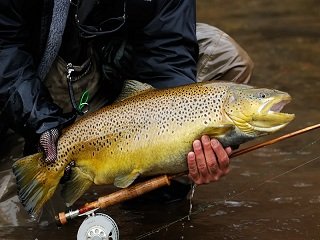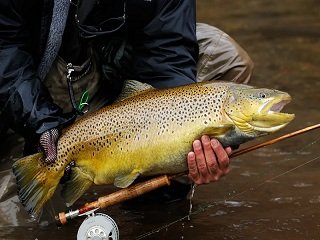 Fly fishermen will be quite familiar with this month’s Fish Files subject, as it is a highly-sought species among the rivers and streams: the brown trout. I, myself, have had the great privilege of catching a few brownies during the winter months and each time I’ve headed out to the river, the trip is always exciting. One of the best qualities of fishing the rivers is that the fish found there spend their time swimming against currents and it gives them more strength. Even the smallest brown trout can put up a fight that rivals most bass. Today, I’ll highlight some of the features of this small, but feisty fish, and provide you with a few common tactics utilized to catch them.
Fly fishermen will be quite familiar with this month’s Fish Files subject, as it is a highly-sought species among the rivers and streams: the brown trout. I, myself, have had the great privilege of catching a few brownies during the winter months and each time I’ve headed out to the river, the trip is always exciting. One of the best qualities of fishing the rivers is that the fish found there spend their time swimming against currents and it gives them more strength. Even the smallest brown trout can put up a fight that rivals most bass. Today, I’ll highlight some of the features of this small, but feisty fish, and provide you with a few common tactics utilized to catch them.
Brown trout are really quite a beautiful species. As their name implies, they’re brown in coloration, but have been known to maintain a silver coloration in certain regions. Normally, brown trout reach sizes of about 1 to 2 pounds, but have been known to reach 40 pounds on occasion. The species is well-known for the dark spots that adorn their bodies, but the silvery variations possess fewer spots than their brown kin.
Preferring cover and structure in streams, such as submerged rocks, overhangs, and vegetation, brown trout look to such ideal spots for shelter from sunlight and predators. Young trout will feed on prey ranging from insects to freshwater shrimp, while adults will prey on smaller fish species, as well as other small animals found in the area, including baby birds, frogs, and mice.
The common method of angling for brown trout is fly fishing. The best preparation when taking your fly gear out to the river for browns is to stop by local bait shops to see what flies are producing results in the area. Brown trout have a taste for cover like rocks, which makes reaching them a little difficult, but casting dry flies upstream and allowing them to float over such spots is a good start. When they’re not active on the surface, try weighted flies, like nymphs, to change their minds.
When float fishing with spinning gear or a centerpin, a variety of baits will work just fine. I’ve caught browns floating shrimp a number of times, for instance. Other options include small jigs, worms, minnows, and even small crawfish. Float these by overhanging banks or submerged rocks and adjust the depth after a few passes. It’s difficult to throw inline spinners or spoons for browns, due to their affinity for structure, but if you can pull it off, give it a try. Just don’t get too attached to such lures, as there’s a strong chance you’ll lose one or two to the river.
Brown trout may not be the biggest fish in the river, but they more than make up for it with a scrappy attitude and a habit of hiding in hard-to-reach locations that will challenge any angler. If you haven’t yet taken a trip to your nearest river to try your hand at these spotted beauties, I suggest picking up some lighter tackle and giving it a shot. They’re such a fun fish to seek out and any day on a river, knee-deep in running water, is better than most other days I can think of.








